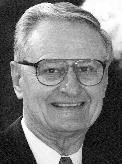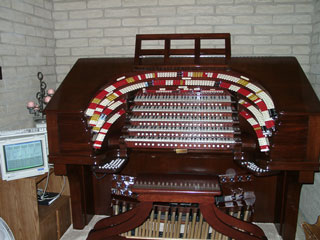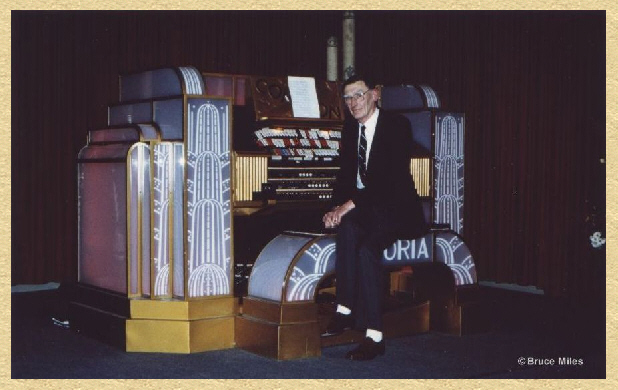TOP STORY
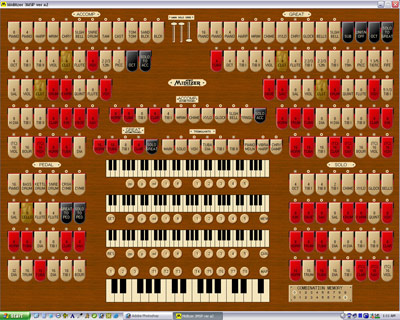
Screenshot of the new MidiTzer 3MSP Virtual Theatre Pipe Organ
Super-Size Your MidiTzer!
The MidiTzer Development team has been hard at work on a 3 manual version of the MidiTzer. The 3 manual version is a combination of the Balaban 4 and the Style 260, each among the biggest 3 manual WurliTzers made. Throw in a few extras from the Style 216 and you've got a really big 3 manual WurliTzer. The 3 manual version is being called the 3MSP, the WurliTzer factory designation for a 3 manual special, an organ not made to a standard WurliTzer plan.
Program developer Jim Henry reports that the 3MSP has so many stop tabs that it is unlikely that it could have been fit into a standard WurliTzer 3 manual console. Joe Barron, a member of the testing team, had this reaction when he first saw the 3MSP:
Sheesh! Is this thing big! Congratulations, you've emulated the intimidation that comes when sitting at big organ consoles. I love it.
DAILY NEWS
02/28/2006
Greetings from the Bone Doctor.
I want to thank the 19,046 visitors to our site this year. God bless all who come here.
02/27/2006
Greetings from the Bone Doctor.
I want to thank the 19,005 visitors to our site this year. God bless all who come here.
19,000 Visitors!
Walnut Hill continues to see very rapid growth this year, with 19,000 visitors since we reset the counter on January 1st of 2005. To date, there have been a total of 28,950 enthusiasts of the King walk through our front door since we went on line in April of 2004.
I want to give you, our loyal visitors, the credit for making Walnut Hill one of the top ranked and most visited Theatre Organ sites on the internet. I also want to give credit to all those who helped us out, both financualy and personally, offereing generous support as we relocated to the sunny state of Florida.
02/26/2006
Greetings from the Bone Doctor.
I want to thank the 18,958 visitors to our site this year. God bless all who come here.
02/25/2006
Greetings from the Bone Doctor.
I want to thank the 18,901 visitors to our site this year. God bless all who come here.
02/24/2006
Greetings from the Bone Doctor.
I want to thank the 18,852 visitors to our site this year. God bless all who come here.
02/23/2006
Greetings from the Bone Doctor.
I want to thank the 18,802 visitors to our site this year. God bless all who come here.
02/22/2006
Greetings from the Bone Doctor.
I want to thank the 18,759 visitors to our site this year. God bless all who come here.
02/21/2006
Greetings from the Bone Doctor.
I want to thank the 18,696 visitors to our site this year. God bless all who come here.
Walnut Hill Gets A
32-Note AGO Pedalboard!
Today, Harold Whipps, fellow VTPO and TOSF member and organ lover, travelled up from Manatee County to deliver a gleaming Conn 32-note AGO pedalboard with the original switch assembly and some nice new reed switches to our studio here in Clearwater. This concave and radiating walnut pedal clavier is in almost new condition and should be a cinch to retrofit to MIDI using the provided reed switches and a soon to be aquired Sound Research encoder from Vern Jones.
Thank you, Harold. We shall dedicate the console to you when it is completed. This pedalboard was the last major hurdle toward building our Virtual WurliTzer. The rest will be easy. We are on our way!
Harold saw the Mighty MidiTzer 3MSP in action and loved it. Bruce Miles' magical pipes rang out with that sweet sound that only comes from a large WurliTzer Theatre Pipe Organ, and the virtual machine infected Harold with the desire to build one for himself. Go get 'em, Harold!
He also got to hear the vintage Conn played, and agreed with me: there is nothing as warm and pleasing as the sound of tubes glowing red on an old Conn, save for the real thing. Gabby sounded sweet today, indeed. She behaved quite nicely, and rewarded us for giving her attention and love.
02/20/2006
Greetings from the Bone Doctor.
I want to thank the 18,640 visitors to our site this year. God bless all who come here.
02/19/2006
Greetings from the Bone Doctor.
I want to thank the 18,600 visitors to our site this year. God bless all who come here.
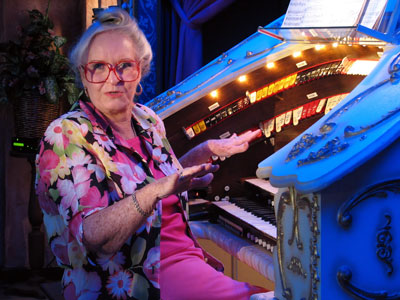
Johnnie June Carter explaining her love for the
3/12 Grande Page Theatre Pipe Organ.
The Central Florida Theatre Organ Society held its monthy chapter meeting at Pipe Organ Paradise in Wimauma Florida, residence of Johnnie June Carter and home her the magnificent 3/12 Grande Page Thetre Pipe Organ.
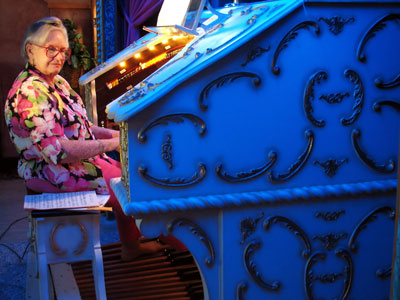
Johnnie June Carter playing the beautiful
3/12 Grande Page Thetre Pipe Organ.
There was quite a turnout for the event, with refreshments served and open console at this very rare Theatre Pipe Organ. Folks took a look at the chambers and viewed the newly installed Combination Action. Johnnie June treated us to several songs from her vast repituer of material before turning the console over to those who wishe d to have a go, including the Bone Doctor and Tom Hoehn.
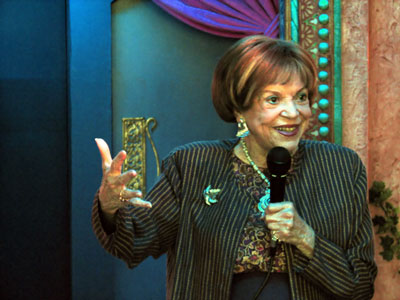
Rosa Rio gives us a history lesson about
the 3/12 Grande Page Thetre Pipe Organ
Attending the event was the Legendary Rosa Rio, House Organist at the Tampa Theatre 3/14 Mighty WurliTzer, who gave us a detailed rundown on the history and lore surrounding this very rare instrument. As usual for Rosa during public apperences, she was in top form and very entertaining. Her in-depth knowledge of Theatre Pipe Organ history is a special treasure, indeed.
Unfortunately, Tom had a busy work schedule. Since Kimmy and I were riding with him, we had to leave the meeting early enough for Tom to get to work on time, so we were not able to stay for her performance.
Next month, the CFTOS will hold its meeting at the Polk Theatre, in Lakeland, Florida, home of the wonderful 3/12 Robert Morton Theatre Pipe Organ.
02/18/2006
Greetings from the Bone Doctor.
I want to thank the 18,568 visitors to our site this year. God bless all who come here.
02/17/2006
Greetings from the Bone Doctor.
I want to thank the 18,513 visitors to our site this year. God bless all who come here.
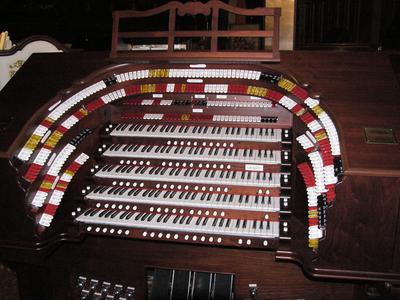
The Mighty Allen TO-5Q Digital Theatre Organ
Opus 1, installed at the residence of Jim Gallops.
Above, it is seen during the 2004 Annual ATOS Convention.
Jim Reid, fellow Walnut Hill Wall of Fame member, WHOC Officer, and field reporter for Walnut Hill Productions, posted this on Walnut Hill's VTPO newsgroup on Yahoo! Music Groups today:
The owner of the Mighty Allen TO-5Q Opus 1, Jim Gallops, is augmenting his five manual Digital Theatre Organ via MIDI and a computer running Brett Milan's Virginia WurliTzer sample set for Hauptwerk 2.
Here is a very interesting post that Mister Gallops made at the Hauptwerk 2 forum. We quote Mister Gallops below:
"I am the owner of an Allen TO-5Q, the largest non-custom Digital Theatre Organ Allen makes. Mine is Opus 1, and was seen at the 2004 Annual ATOS Convention.
This instrument has 3 Tibias. All are sampled WurliTzer Tibias without tremulants and have the trems generated by low frequency oscillators in the digital sample processors along with the tremulant waveforms. This is very similar to what Hauptwerk 2 does. I added a fourth Allen Tibia sample to the instrument, which is a Tibia with the tremulant on in the sample.
Actually only about 2 octaves have the sampled tremulant on and the rest have the trem generated by the low frequency oscillator. Well, you can't tell which notes have sampled trem from the ones that are low frequency oscillator tremmed, since the two trem methods sound identical. Ditto for the other Tibias that have all of their trems generated by low frequency oscillators, and then playing the Tibias with the sampled trems. They all blend nicely, too!
So, it seems like a lot of noise is being made about having to sample Tibias and Voxes with their trems on when, in fact, you don't have to and it still sounds authentic and credible. For those of you who have access to an Allen LL324Q, go play the Tibia, which has about 2 octaves of trem that is sampled and the rest LFO generated and tell me where the break points are from sampled trem to generated trem. I know exactly where they are since I had to install it on the Allen TO-5Q.
I have a computer running Hauptwerk 2 hooked up via MIDI to the Allen TO-5Q to provide stops I don't have on the instrument. The audio is provided by the Allen TO-5Q and Hauptwerk 2 plays back through the Allen TO-5Q amps via its EAC box. IR reverb is added by the Allen TO-5Q, so you can't tell where the voice was generated from.
The Allen TO-5Q is also an
excellent instrument to launch virtually into another builder's Theatre Organ using those samples via Hauptwerk 2, and at some point, I would also like the instrument to have the voices of a big Kimball or Barton. That is what I fully intend to do, since this hobby of ours is really about pleasing ourselves as owners and players. Software such as Hauptwerk 2 gives us many choices and the opportunity to explore them all.
With that being said, the Allen TO-5Q is an excellent instrument as sold by the Allen Organ Company. It will more than satisfy most people on the planet who want the wonderful sound of a Theatre Pipe Organ in their living room, and then some. As it sits now in my music room, the instrument does indeed sound like a big WurliTzer Theatre Pipe Organ, and not a digital instrument.
All the best,
Jim Gallops"
You can read the original unedited version of the above post if you should care to do so by clicking here. Mister Gallops' post is well down the page of comments.
After a few responses to that post, Mister Gallops posted a follow up. This is where some very interesting information is revealed (at least I find it so.) Again, we quote Mister Gallops:
"Allen's samples are proprietary to Allen and are encrypted, so they do you no good on anything else (including Hauptwerk 2,) except for another Allen. However, you can move samples between Allen models. I do it all the time. If you have other Allen questions, please email me directly since this is not an Allen forum.
I have Hauptwerk 2 on my Allen TO-5Q for precisely the reverse reason you stated. Namely, I want to go out and sample really good Theatre Pipe Organs and use those samples on Hauptwerk 2.
I will then one by one remove the voices from the Allen TO-5Q and use Hauptwerk 2 to generate the voice I want. I can use the freed up stop tab(s) to control Hauptwerk 2 directly from the console, so no touch screen is required. I do not want to be limited by the manufacturer (in this case Allen) with their selection of samples (or lack of them.)
I personally prefer the sounds of a Kimball or Barton to a WurliTzer. When was I ever able to get these samples from Allen?? Well, never sort of comes to mind.
This is what started my interest in Hauptwerk 1 originally, and of course, prompted the question to Martin Dyde about being able to do theatre style trems.
Hauptwerk 2 is of course the answer. I have lined up a couple of places to sample what I want on my Allen TO-5Q. If things turn out OK and I like what I get, then I will make the samples available through Milan Digital Audio.
Jonas Nordwall and Jelani Eddington have provided suggestions to me on what venues are in really excellent repair and are excellent examples of the particular builder I am interested in. Of course, this does not rule out finding a good WurliTzer and sampling it, since I am not averse to compiling an organ made out of ranks from many different builders. (Jasper Sanfillipo's instrument is such an instrument.)
I have an excellent platform with the Allen TO-5Q, even if I turn off all the Allen tone generation and use Hauptwerk 2 exclusively. Hauptwerk 2 understands the NRPNs the Allen TO-5Q sends for its stop changes. However, there is a small issue with program changes, which send no NRPNs. So you have to keep your real capture system in sync with the virtual capture system on Hauptwerk 2, otherwise things don't work quite right.
If you want my email address for private Allen concerns, you can find me on the Yahoo! Music Groups Allen Organ Owners Newsgroup.
Best Regards,
Jim Gallops"
So there you have it, from the owner of the Mighty Allen TO-5Q Opus 1, Jim Gallops.
Recall that Jelani Eddington recorded several of the Virginia demo tracks for Brett's demo pieces of his Virginia WurliTzer sample set. Apparently, he liked what he heard!
It is interesting to note that back on January 30th of 2006, Brett Milan, in a response to some criticism of the Virginia WurliTzer sample set, posted the following, and we quote him in part below:
"When they talk bad about the demos and the organ, they are putting down the organ itself and all of those that have worked on the instrument to keep it alive throughout the years. This is a small 8 rank WurliTzer that is in need of attention and certainly must not be compared to the top notch well maintained Theatre Pipe Organs that those with plenty of money have to put into them. The Virginia Theatre is always looking for revenue to put towards the theatre and the organ.
I am happy to state that we will be donating money from the sale of each Virginia WurliTzer sample set CD to the Virgina Theatre's organ fund. So, perhaps those that complain about it can do something by buying the CD and helping out the organ. Or they can go support the giants who squash about 400ms into their samples. I've received numerous emails complimenting the Virginia WurliTzer sample set, so I am not going to let these folks bother me. Perhaps they should visit the Virginia Theatre and hear the organ for themselves.
That said, it should be known that we will be putting together a 'high caliber' theatre organ over the course of the year. It should be a fairly large set and
will contain high quality Theatre Pipe Organ samples throughout. Once we have more information, I will gladly let you know more about it. Until then I do hope that this first little WurliTzer will tide you over and give you something to work with and have fun playing."
That last paragraph above by Brett Milan, along with the posts by Jim Gallops, is exciting news and certainly gives me a whole lot to look forward to over the coming months of 2006!!!
Best to all,
Jim Reid
02/16/2006
Greetings from the Bone Doctor.
I want to thank the 18,476 visitors to our site this year. God bless all who come here.
02/15/2006
Greetings from the Bone Doctor.
I want to thank the 18,411 visitors to our site this year. God bless all who come here.
Bob Davidson Gets A Server!
This evening, Bob Davidson, Vice President of the American Theatre Organ Society, took delivery of his new Microsoft Windows 2000 Server SP4 computer that was being built for him by CoyoteNET Digital System Solutions.
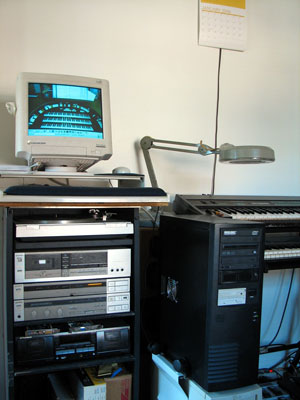 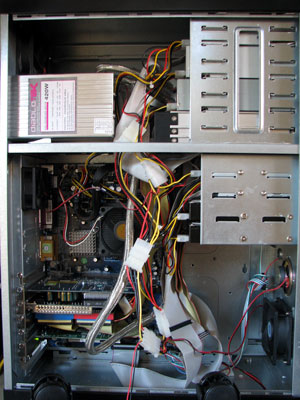
On the left, Bob Davidson's new server undergoing final testing.
On the right, the insides of Bob Davidson's new server.
This is a monster machine based on AMD/VIA technology with a 2600 Sempron CPU. It is rather unique among the machines we have assembled in that there are four ATAPI devices including a CDRW, DVD Reader and DVD Burner, along with an Iomega ZIP drive. It has an aluminum removable hard drive drawer with a cooling fan for extra storage and two internal 80GB Maxtor ATA 133 hard drives, a standard floppy, 1 GB of PC 2700 DDRAM, an nVidia 4X GForce4 MX/400 64MB AGP video engine, a D-Link 100MIPs LAN card, and onboard stereo audio. It is powered by a 450 watt PSU. The monitor pictured belongs to the shop and is used for building and testing, an old but trusty 15 inch Gateway Vivitron CRT.
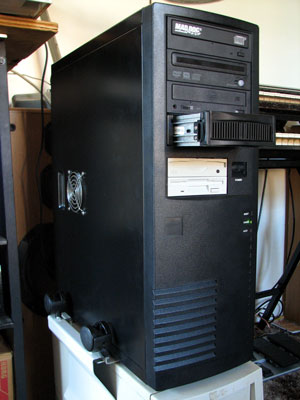 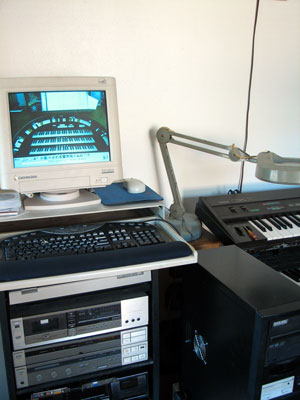
On the left, Bob Davidson's new server with the hard drive drawer extended.
On the right, Bob Davidson's new server just moments before delivery.
In the shots above can be seen the Logitech Elite Keyboard which allows one touch access to many of the functions on this very powerful SOHO server. The software bundle includes Windows2000 Server SP4 with DirectX 9c and Internet Explorer 6.1, Windows Media Player 9, AVG Free Edition, ZoneAlarm Free Edition, AdAwareSE Personal, SpywareBlaster, Spybot Search & Destroy, Microsoft Office 2002 Small Buisiness Edition, Adobe PhotoShopCS and Acrobat Reader 7.07, Nero Burning ROM Enterprise Edition, CD Architect 5, SoundForge 6, and Sonar 2.2 with Waves DX Audio Plugins.
And there you have it. Another success story for CoyoteNET Digital System Solutions. Bob Davidson now has a great machine to use as he endevours to do great things for the ATOS.
02/14/2006
Greetings from the Bone Doctor.
I want to thank the 18,363 visitors to our site this year. God bless all who come here.
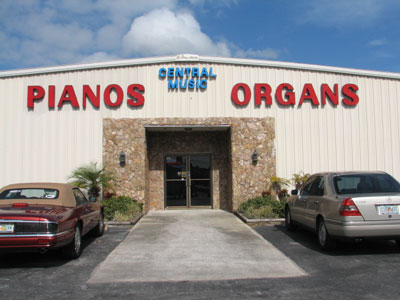
Central Music front entrance
5175 Ulmerton Road, Clearwater, Florida
On Hanuary 17th of 2006, Central Music at 5175 Ulmerton Road in Clearwater, Florida hosted a performance by Tom Hoehn accompanying the classic silent short movie entitled The Rink starring Charlie Chaplin.
We have added a new page in Tom Hoehn's pages in the Featured Artists section dedicated to this fine performance. Click here to see the new page featuring seven tracks from the show!
02/13/2006
Greetings from the Bone Doctor.
I want to thank the 18,335 visitors to our site this year. God bless all who come here.
02/12/2006
Greetings from the Bone Doctor.
I want to thank the 18,292 visitors to our site this year. God bless all who come here.
An Editorial by Per Olof Schultz, Walnut Hill Organ Club
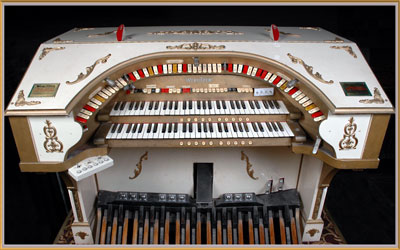
Looking down at the console of the
Virginia Theatre's 2/8 Mighty WurliTzer Theatre Pipe Organ.
Hi, Gang.
Since a couple of days ago, I have had the subject gadget up and running. Following are my very subjective thoughts.
It was very easy to install, but it took some time. Setting it up with the MIDI stuff was not straight forward. Although logical, it was still complicated.
Presently, I have only the pistons working. The stop keys will be done later. The first thing you see on your screen is the console. This is a photo realistic console. It looks like the picture above. Everything works like the real thing. You can hit keys, stops and pistons just like we are used to doing at an actual Theatre Pipe Organ.
People with touch screens are out of luck with this display. It's also difficult, if not impossible, to read the text on the controls. Luckily, there is another display just a mouse click away which looks like the MidiTzer layout, but with no keyboards. Here, everything is legible. All of the stop keys are actual photos of the real thing.
Another display shows the chamber with the regulators and wind demand. If you switch on the trems, the regulators shake just like the real thing. Do they sound? Yes, there is blower noise in the background. Of course, it changes if the trems are on, different for each trem. Funny, but you can always argue about how useful it is. More interesting is the noise from the combination action. It also varies depending on how many stops are drawn.
Does it even sound? Yes, provided you switch the blower on. Does it sound like a real WurliTzer? Hard to tell for me, as I have only limited experience in this area. I did visit my friend who has a real 2/7 instrument in his basement just a couple of months ago. At that time, I really sat down and listened carefully to each rank. In his installation, the console is only a few meters away from the chamber, which is different from a normal installation.
As far as I can tell, the Virginia WurliTzer for Hauptwerk 2 is not too far away from the real thing. You will probably have to read most of the comments from others regarding the Virginia, ranging from crap to excellent. Recently there have been made available at the Theatre Organ SoundFonts newgroup on Yahoo! Music Groups some comparison recordings for you to judge. These three tracks by Walnut Hill VTPO member Roger Dunk are easy to distinguish, but which is the best one? You decide.
There have been some discussions about trems, synchronized or not. I have never been bothered by Bruce Miles' Cinema Organ SoundFont trems on the Sound Blaster being out of sync. In fact, I can't hear this. In my MidiTzer, I have a mixture of Bruce Miles' and John Tay's SoundFonts. But I never wholeheartedly liked the Tibias from John Tay. They are alright when playing single notes. The Virginia WurliTzer sample set and John Tay's SoundFonts sound similar note by note, but if you try chords with 8' and 4' Tibias, there is a difference. The Virginia sounds a lot better to me, and this could be the trems, which are synchronized like the real thing.
Were there any problems? Yes. The Chrýsoglott brings my computer to its knees. Strange, but there seems to be a problem with Hauptwerk 2, but I think this will be resolved soon. I will not be buying a new computer in the near future to remedy this.
To Jim Reid, a fellow Hauptwerkian, you will be OK, as computers with the speed of light and terabytes of memory are not affected!
So which WurliTzer simulator is the best? No answer from me, as I don't think you can compare the Virginia with MidiTzer. They are directed toward different "markets". Which is best, a motorcycle or a car? Both will take you from point "A" to point "B". My MidiTzer nametag is firmly attached to my instrument and will remain there.
Have fun, May is approaching fast!
Per Schulz, WHOC, Assistand Editor, Walnut Hill Gazette
02/11/2006
Greetings from the Bone Doctor.
I want to thank the 18,237 visitors to our site this year. God bless all who come here.
Frank Vanaman, fellow Wall of Fame inductee, has uploaded a new shot of his Mighty MidiTzer setup. Also included is a picture of his MOTM Modular Synthesizer.
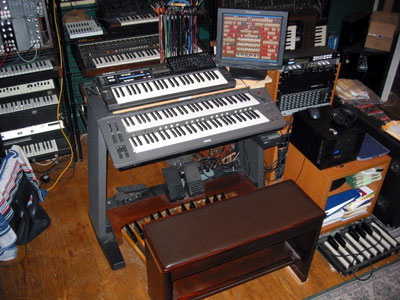
Frank Vanaman's Mighty MidiTzer.
We quote Frank below:
You can see my Yamaha HX-1 (really CHX-1 innards on an HX stand - note the wood CHX-1 pedalboard!), Casio CZ-1000 for the Solo manual, Planar 17" touch screen monitor. What looks like another synth keyboard behind the casio CZ is actually in a rack about a foot and a half behind the console. I just got the angle of the picture a bit wacky.
02/10/2006
Greetings from the Bone Doctor.
I want to thank the 18,144 visitors to our site this year. God bless all who come here.
Taking the TPO Mainstream
The Walnut Hill Productions Team has been doing a bit of promotion and educating off site at one of the world's largest gathering of digital artists known as deviantART. We have three accounts there. The Bone Doctor has set up a journal in his account in the name of Slow Dog, containing a rather extensive Special Feature on the King of Instruments.
Doc's account has many sections, one being a Gallery of the Bone Doctor's own artwork, another of his favourite images from those who are known on deviantART as "fellow deviants", and lots of other goodies and links to other places in the world of this rather eccentric and crusty old professor.
At deviantART, all works done by the artsts of this community are called "deviations". Below is a small sampling of the Bone Doctor's "recent deviations".
|














